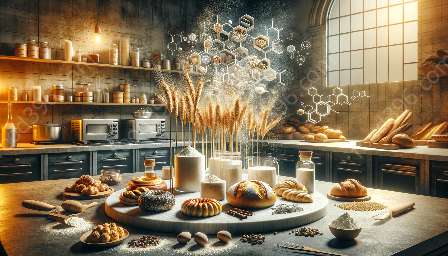Sugar and sweeteners are vital ingredients in baking, not only for sweetness but also for controlling texture, color, and flavor. In this topic cluster, we will explore the role of sugar and sweeteners in baking, their compatibility with other baking ingredients, and the science and technology behind successful baking.
Sugar: The Essential Sweetener
When we think of sweetness in baking, sugar is the first ingredient that comes to mind. Sugar plays multiple essential roles in baking, including providing sweetness, ensuring tenderness, aiding in leavening, and contributing to the overall structure of baked goods. Sucrose, the most common form of table sugar, caramelizes during baking, adding a desirable golden color and contributing to the flavor profile of the baked goods.
Furthermore, sugar helps retain moisture, resulting in moist and soft baked goods. It interacts with other ingredients, particularly fats and liquids, to create a desirable texture, making it a fundamental component of many baked goods.
Sweeteners Beyond Sugar
While sugar is a staple sweetener in baking, there are several alternative sweeteners that have gained popularity due to health concerns and dietary restrictions. This includes honey, maple syrup, agave nectar, and stevia, among others. These alternative sweeteners not only provide sweetness but also add distinct flavors and textures to baked goods.
When using alternative sweeteners, it's essential to adjust the recipe to accommodate their unique properties. For instance, honey and maple syrup are liquid sweeteners and require adjustments to the liquid content in the recipe. Similarly, the sweetness intensity of alternative sweeteners differs from that of sugar, requiring modifications to achieve the desired sweetness level in the final product.
Compatibility with Flour and Other Baking Ingredients
Understanding the compatibility of sugar and sweeteners with other baking ingredients is crucial for achieving successful baking outcomes. Sugar interacts with flour and other ingredients to influence the texture, color, and flavor of the finished baked goods.
Flour-Sugar Interaction
Flour and sugar work together to create the structure and texture of baked goods. When combined with flour, sugar helps weaken the gluten structure, resulting in tender and moist baked goods. It also aids in browning due to caramelization and enhances the flavor profile of baked goods.
Additionally, sugar crystals can help incorporate air into the batter or dough, resulting in aeration and volume in the finished product. However, excessive sugar can also inhibit gluten development, leading to overly fragile or crumbly textures.
Sugar and Other Baking Ingredients
In addition to flour, sugar and sweeteners interact with fats, leavening agents, flavorings, and other ingredients commonly used in baking. For example, sugar and fats, such as butter or oil, create a tender and moist crumb in baked goods. When combined with leavening agents, such as baking soda or yeast, sugar contributes to the leavening process, aiding in the rise and structure of the final product.
Baking Science & Technology
Baking is not just an art; it is also a science. Understanding the science and technology behind baking is essential for achieving consistent and high-quality results. When it comes to sugar and sweeteners, their chemical properties and interactions with other ingredients play a crucial role in the success of baking endeavors.
Chemical Reactions
During the baking process, sugar undergoes complex chemical reactions that contribute to the overall structure, flavor, and color of the baked goods. For instance, caramelization of sugar at high temperatures leads to the formation of desirable flavors and colors, enhancing the sensory experience of the baked goods.
Furthermore, the interaction between sugar and proteins in the presence of heat contributes to the browning of baked goods, known as the Maillard reaction. This reaction not only enhances the visual appeal of baked goods but also adds depth of flavor.
Technology in Baking
The use of technology, such as precise measurements, temperature control, and understanding the functionality of ingredients, including sugar and sweeteners, is crucial for consistent baking results. Modern baking equipment, such as mixers, ovens, and thermometers, allows bakers to control the baking environment, ensuring that the chemical reactions and physical transformations during baking occur optimally.
Additionally, advancements in sweetener technology, such as the development of sugar substitutes and alternative sweeteners, have enabled bakers to cater to a diverse range of dietary preferences and restrictions without compromising the quality of the final baked products.
Conclusion
Sugar and sweeteners are integral components of baking, influencing the sensory characteristics and structural integrity of baked goods. Understanding their role, compatibility with other ingredients, and the science behind their interactions is crucial for achieving consistent and high-quality results. By delving into the world of sugar and sweeteners in baking, bakers can elevate their baking skills and create delightful treats for all occasions.

